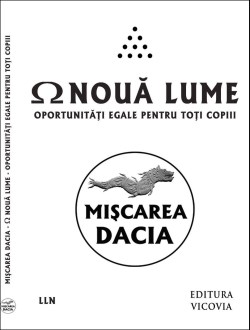 Vă invit să vă alăturaţi grupului Facebook Mişcarea DACIA, ce-şi propune un alt fel de a face politică!
Vă invit să vă alăturaţi grupului Facebook Mişcarea DACIA, ce-şi propune un alt fel de a face politică!Citiţi partea introductivă şi proiectul de Program, iar dacă vă place, veniţi cu noi !
O puteţi face clicând alături imaginea, sau acest link
Archive for Settembre, 2019:
Awakened
Să fii Treaz într-o Lume Nebună este atât o binecuvântare, cât şi un blestem. Trăim într-o Lume Nebună guvernată de Oameni Nebuni cu obiective nebuneşti, dar probabil că o să mă facă nebun dacă spun că asta e o nebunie. Oamenii pot să-mi spună „Nebun”, de vreme ce cred că mă vor numi „Drept” în final… dar va fi prea târziu.

To Be Awake In An Insane Nation Is Both A Blessing And A Curse. We Live In An Insane Nation Ruled By Insane People For Insane Objectives, But I’m Likely To Be Called Insane For Saying It, And That’s What’s Insane About It. People can call me “Crazy”, as I think I’m going to be called “Right” in The End, but then it will be too late.
Music
L-Y-R-I-C-S: FACE OUR TIME
Beyond the shine of bling bling
Your house your car your boat
You camouflage your unsureness not to be enough
Beyond material values
Your house your car your boat
You camouflage your deeply fears
Face-lifting liposuction
Alright I pay my new life
So sick
This way to kill our dreams
Let’s fight this fuckin’ shit
Face our time
This is where we live
For every fucking diamond and every fucking coat
You loosing basic values
Supporting poverty
Because (that’s why) your wealth (we fight)
Was made on human backs
And your achievement your success
Is nothing more than human beings’ blood
We’re spending so much time
To build up our life
On artificial values
Face our time
Your house your car your boat
Your house your car
Fuck you
It’s our frustration and aggression
(fight)
Tags: Music
Hyperian History Of The World (18th Century, Part 3)
Brice Merci
Iniţiator de conversaţii · 1 oră
Hyperian History Of The World (18th Century, Part 3)
The philosophy of the British empiricists in the 18th century as well as that of Immanuel Kant suffered from a lack of mathematics. Leibniz had been more than aware that his philosophy required further mathematical rigour in order to escape from the mire of metaphysical interpretations and attain to the purest of reason. Unfortunately, the 18th century represents the fracture of intellectual pursuits which we still see to its extreme in the academic world today. Leibniz had been a great polymath, excelling in all manner of disciplines and combining them all together in order to further his own understanding of everything. Newton, on the other hand, had been a great mathematician and scientist, but had had little philosophical understanding, thus failing to see the contradiction of combining empiricism with rationalist mathematics. The British empiricists were the opposite of this, great philosophers but with little mathematical knowledge.
This problem is also shown by looking at the mathematicians of the 18th century. Whereas Leibniz had been a great mathematician as well as a great philosopher, who had pioneered new mathematical disciplines in order to express his philosophy mathematically, the mathematicians who followed him and built on his work were great mathematicians but were not philosophers. Therefore, although they provided great mathematical insights which would have helped Leibniz enormously, no philosophers of the time thought to utilise their work.
The greatest mathematician of the 18th century was Leonhard Euler. Euler made major developments in almost all areas of mathematics, from trigonometry and calculus to algebra and geometry. Building on Leibniz’s pioneering work in calculus, Euler made major developments to analysis and power series. He also discovered the base of the natural logarithm, a number which is still known as ‘Euler’s number’, or just ‘e’.
Using this number, Euler explored ways of expressing logarithms with power series and then began to utilise complex exponentiation, utilising the imaginary constant, ‘i’. Through this work, Euler discovered an astonishing result. The power series expressions for exponential functions simplified to expressions which Euler noticed were equal to trigonometric functions. Amazingly, he realised that when ‘e’ was raised to an imaginary power, the result was equal to the sum of the cosine function and the sine function with an imaginary coefficient. His remarkable formula is expressed as: ‘e^ix = cos x + i sin x’.
For mathematicians, this was an exciting result, although they only saw it in terms of the abstract mathematics that they were studying. Philosophers, who ought to have realised the true implications of this formula, were either ignorant or indifferent to these mathematical developments. Leibniz may well have made the connection, but, alas, he was long dead before Euler made this discovery. Yet this formula, and what it revealed, was exactly what Leibniz had been seeking in his pursuit of the mathematics necessary to underpin his philosophy.
Euler knew his discovery was astonishing, yet even he did not realise just to what extent. Unbeknownst to him, Euler had in fact discovered the mathematical expression of the most very basic element of reality, the ‘arche’ of the ancient greeks, the foundation upon which all of reality is built. Unfortunately it would take centuries before this was realised by anyone, after further developments in mathematics and philosophy and the combination of it all together by great, unknown geniuses working behind the scenes.
But back in the 18th Century the world was still very much awakening into a much more scientific outlook on things, with these developments in mathematics greatly assisting scientists in their empirical attempts to explain the world around them. If only the philosophers had made similar use of mathematics…
This mathematical shift in human thought of the time was also felt in other areas, most interestingly in music. In the previous century, baroque composers such as Monteverdi had taken music to new heights of creativity, peaking in opera, yet the 18th century would see music taken much higher. It had been known since Pythagoras that music was a very mathematical discipline and the rules of harmony that had been established over the centuries could almost be said to obey mathematical laws, as if a composer could, in theory, compose beautifully harmonious music simply by making mathematical calculations.
This mathematical approach to music reached its zenith in the late baroque in the first half of the 18th century, chiefly in the work of its key composers, the Italian Antonio Vivaldi, and the Germans, Georg Frideric Handel and, greatest of all, Johann Sebastian Bach. Handel, who ended up based in London, wrote many operas and other concert works, yet his specialism was the sacred Oratorio, a format in which Handel was able to combine operatic solos, complex, contrapuntal orchestral passages and huge, glorious choruses.
Handel’s ideas were best realised in his monumental oratorio ‘Messiah’. Although ostensibly a christian work celebrating Jesus Christ, this was really a transcendent work, one whose biblical text is arranged in such a way as to abstract the christian message so that it can easily be reinterpreted in a spiritually uplifting way, with the concept of the ‘messiah’ being viewed as a divine state which we can all attain, and which Handel gives us a glimpse of in musical form. After composing the famous ‘Hallelujah’ chorus, the work’s emotional high point, Handel was found in his study in an almost trance-like state and, once roused, he gestured at the score and stated, “I thought I saw the face of god!”
While Handel became the most famous composer in Europe, his great contemporary, Johann Sebastian Bach was a much more esoteric composer, keeping himself shut up in his little german church playing the organ and composing a huge body of amazingly complex works. His compositions took the art of harmony and counterpoint to perhaps their greatest heights. Whilst most composers occasionally composed two melodies playing together to give a little colour to the music, Bach took counterpoint to extremes, often having, three, four, five, even six melodies all playing at the same time yet without losing the sense of perfect harmony. Listening to some of Bach’s contrapuntal works is almost like listening to the sound of beautiful mathematical equations in operation.
But, like Handel, Bach also composed large-scale sacred works. His greatest oratorio, the St Matthew Passion, is an intense, deeply powerful work in which Bach throws everything he has into the mix, creating a musical extravaganza even more complex and varied than any opera of the time. This work was surpassed in his later, greatest masterpiece, the Mass in B minor, completed shortly before his death in 1750. Alas, Bach, who perhaps had the most complete grasp of musical theory of any composer of all time, surely one of the greatest musical geniuses of all time, was not very popular during his life and it took several centuries for his greatness to be appreciated and for him to be placed in the highest pantheon of composers, where he truly belongs.
Bach and Handel brought the long Baroque age of music to a close. Following their complex and heavily ornamented music, composers began to streamline their music, creating a wonderfully elegant style which we know today as the ‘classical’ period. In this period, opera was reformed by the works of Christoph Gluck and many of the great musical forms, such as the concerto, the string quartet, and especially the symphony, were perfected by Austrian composer Franz Josef Haydn.
Haydn’s beautiful compositions were seeing him well on his way to becoming the most famous composer since Handel, but then his genius was soon eclipsed by a mere child, a prodigy who would take the musical world by storm unlike anyone else had ever done or has ever done since, Wolfgang Amadeus Mozart.
Mozart was perhaps the most naturally gifted musician of all time. He began to play the piano at the age of three and was composing melodies at five. His father began parading him around Europe giving concerts to the astonishment of all who saw him. At eight he wrote a symphony and at fifteen, a full opera. Mozart soon became famous all over Europe as a composer as well as a performer, becoming the greatest virtuoso pianist of the time. After settling in Vienna in 1782, Mozart took his composing to its greatest heights with his great operas, The Marriage Of Figaro, Don Giovanni and the wonderfully esoteric The Magic Flute. He also composed grand symphonies, eclipsing Haydn’s work in that genre and his piano concertos would draw huge crowds who were amazed by Mozart’s elegant composition as well as his stunning ability to improvise on the themes of the works.
In 1791, Mozart was commissioned by a mysterious unknown source to compose a Requiem mass. After having scored a little over half of the work, Mozart tragically died at the age of just thirty five, leaving one of his students to complete the great Requiem, perhaps the greatest choral work since Bach. In his short life Mozart composed a huge amount of music, seemingly able to churn out beautiful compositions without really trying. When he did try, however, his music achieved true glory, with levels of beauty and elegance never matched by anyone else, a huge amount of passion and also a great sense of humour. Mozart eclipsed every one of his contemporaries, even the great Haydn, who reemerged only after Mozart’s death to compose his greatest work, the oratorio The Creation.
The music of the great composers of the 18th century is the perfect soundtrack to the enlightenment values of the time and the scientific and mathematical advances that were being made resulting in some of the greatest artistic creativity since the renaissance. Yet towards the end of the century, political events would occur which would cause a great shift in human consciousness, resulting in a new age of passionate and romantic creativity. Music had become a powerful force in the world, which was able to bask in the transcendent glory of the genius of Handel, Bach, Haydn and Mozart.
/https://www.facebook.com/equazionedirac/videos/371012500231604/

Cioran
Oamenii sănătoși, normali, mediocri nu pot experimenta nici agonie, nici moarte. Trăiesc ca și cum viața ar avea un caracter definitiv. Este o parte integrantă a echilibrului superficial al oamenilor normali pentru a lua viața independent de moarte și a considera moartea ca o realitate care transcende viața. De aceea, ei percep moartea ca venind din afară, nu ca o fatalitate interioară a vieții în sine. Una dintre cele mai mari amăgiri ale omului obișnuit este să uiți că viața este prizonierul morții. Revelațiile metafizice încep numai atunci când echilibrul superficial al unuia începe să se dezlănțuie și o luptă dureroasă este înlocuită de spontaneitatea naivă. Presimțirea morții este atât de rară la oamenii obișnuiți, încât practic se poate spune că nu există. Faptul că presimţirea morții apare numai atunci când viața este zgâlţăitătă
din temeliile sale, dovedește dincolo de îndoială, imanența morții în viață. O perspectivă asupra acestor adâncimi ne arată cât de iluzorie este credința în integritatea vieții și cât de bine a întemeiat credința într-un substrat metafizic al demonismului.
Extras din On The Heights of Dispair de E. M. Cioran

Healthy, normal, mediocre people cannot experience either agony or death. They live as if life had a definitive character. It is an integral part of normal people’s superficial equilibrium to take life as absolutely independent from death and to objectify death as a reality transcending life. That’s why they perceive death as coming from the outside, not as an inner fatality of life itself. One of the greatest delusions of the average man is to forget that life is death’s prisoner. Metaphysical revelations begin only when one’s superficial equilibrium starts to totter and a painful struggle is substituted for naive spontaneity. The premonition of death is so rare in average people that one can practically say that it does not exist. The fact that the presentiment of death appears only when life is shaken to its foundations proves beyond doubt the immanence of death in life. An insight into these depths shows us how illusory is the belief in life’s integrity and how well founded the belief in a metaphysical substratum of demonism.
Excerpt from On The Heights of Despair by E. M. Cioran
Artwork by Eric Lacombe
The Historical Illuminati

The Historical Illuminati
In contemporary mythology, the Illuminati have been branded as the puppetmasters who stand behind the establishment, pulling the strings, orchestrating the enslavement of the people of the world. The opposite is true. The Illuminati have always led the resistance against the tyrants. On occasions, they have come tantalisingly close to success, but mostly they have endured catastrophic defeats. They have tried to infiltrate the establishment, tried Trojan Horse strategies, guerrilla tactics and popular uprisings, tried to win the intellectual and religious debate, tried to subvert and undermine the establishment. Most attempts have ended in disaster, with the establishment unmolested and more powerful than ever. But it is never acceptable to surrender or abandon the struggle.
Too many people retreat into their micro-worlds of petty comforts where they pose no threat to the establishment, and that’s exactly what the establishment desire – our compliance and obedience, our refusal to stand up to them. The game of the establishment is nothing new. It was explicitly set out in Machiavelli’s The Prince, which baldly states the unscrupulous principles of how those with power should hold onto it. Lying, cheating, brutality, cruelty, pitilessness, inspiring fear and terror, breaking solemn oaths, hypocrisy, greed, bribery and corruption, extermination of rivals, making pacts with your enemies only to break them when it suits you, are all advocated as necessary tools. This behaviour is still on display every day from every government on earth.
The Illuminati have had a number of guises in the public arena, have formed many alliances and have founded many groups that they have used for particular purposes in the ongoing struggle against tyranny. But the objective has always been the same – to destroy the Old World Order, the network of powerful dynastic families and privileged elites who have engineered earthly wealth and power for themselves, and to hell with everyone else. The Old World Order were the masters thousands of years ago and they are the masters now. They assiduously follow the advice of Machiavelli, but they didn’t need him to tell them the rules of the game. Machiavelli merely described what they had been doing for millennia.
Through every disaster, the OWO endure. Has the latest financial disaster dented their power? Not in the slightest. Nothing has changed. People talk about doing this and doing that against them, but in reality nothing happens. The system is locked down. It is impossible to change it within its own parameters. It is designed to be resistant to anything other than revolution, but there are few revolutionaries left in the world. The Old World Order’s system is close to perfection. It is a matrix of absolute control. Only a small number of people (some 6,000) run the world, yet they are backed up by all the agencies of oppression: the police, the military, the intelligence services, the law (designed, ultimately, to protect the assets of the rich). The billions of ordinary people in the world, who could sweep away tyranny in an instant, are too scared to fight back. They are cowed and docile. They are the “last men” to whom Nietzsche referred so derisively.
The Illuminati’s mission, in one sense, is to help last men regain their dignity, to throw off their chains and stand up straight for once. How is that to be done? By putting people in touch with their higher selves. When the divine spark is released in an individual, he no longer tolerates the condition of slavery, no longer mires himself in trivia and meaningless pursuits to pass the time. Above all things, the Old World Order fear what would happen if their manufactured mastery were challenged by legions of those who had found their higher selves and lost their fear. As will be shown below, many brave groups have resisted the OWO. The vastly more numerous forces of the OWO crushed them, but it will not always be so. “The darkest hour is just before the dawn.”
Excerpted, page 300
© The Illuminati’s Secret Religion
Artwork by Raceanu Mihai











